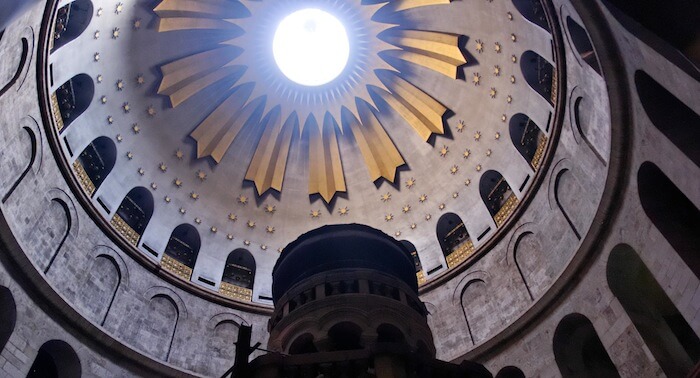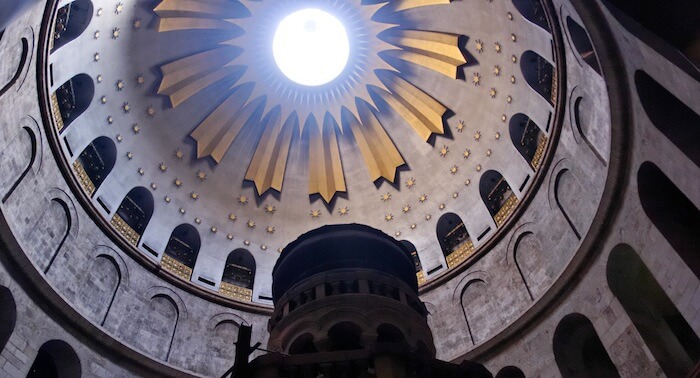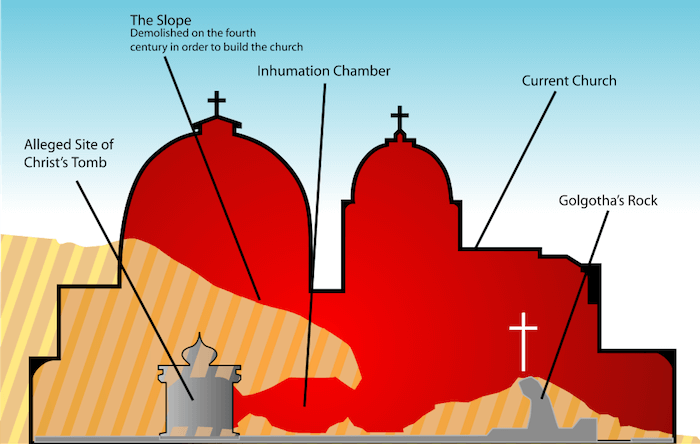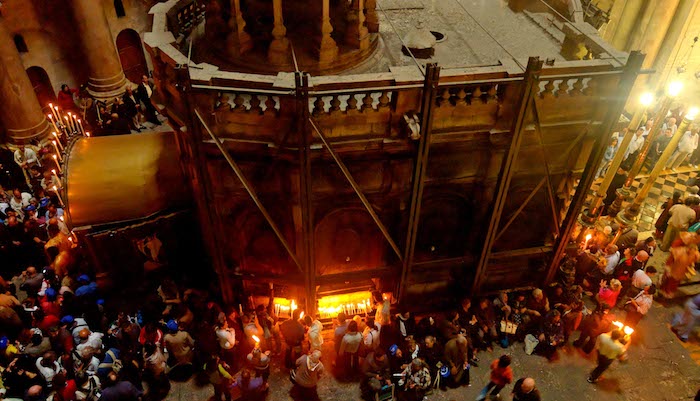3 min read
Jerusalem’s Church of the Holy Sepulchre Shows Our Need for a Savior
Admin
:
Jun 20, 2017 11:01:45 PM

One of the biggest surprises to Christian pilgrims in Jerusalem occurs when they step inside the Church of the Holy Sepulchre. The site of Jesus’ crucifixion and resurrection falls short of the expectations of many Christians accustomed to Western worship.
Gold drips from icons. Chanting fills the spaces. Incense rises between cold stone walls. Six sects of Christendom betray jealous rivalries over the goings-on within. Territorial fistfights even occur on occasion.

(Photo: The Holy Sepulchre’s dome covers Christ’s tomb. Courtesy of the Pictorial Library of Bible Lands)
Without proper mental preparation, a Christian pilgrim may see only the distracting depravity of religion that has affixed itself to this site like barnacles on sunken treasure.
But if we look past today’s traditionalism to history’s tradition, we find an unbroken connection to the central event of all time—the redemption of the universe.
For in this place, Jesus Christ died for your sins and rose again.
The Church of the Holy Sepulchre—Its Story
The earliest and strongest Christian tradition places the location of Jesus’ crucifixion, burial, and resurrection at the site where the Church of the Holy Sepulchre stands today.
- The Aramaic name of the original, rocky outcropping, Golgotha (calvaria in Latin), reflects death in its translation: “The Place of a Skull” (John 19:17).
- The Jerusalem Christian community held worship services at this site until A.D. 66.
- The Judeo-Christian synagogue at the site of the Upper Room on modern Mount Zion faced the Church of the Holy Sepulchre, rather than the Temple Mount.
- After the Emperor Hadrian destroyed Jerusalem and divided it into its quarters, he erected a temple to Aphrodite over the site.
- During the fourth century, Constantine tore down the pagan temple and rebuilt a church on the site to memorialize the place of Christ’s resurrection.
- In 1009 the Egytian ruler Al-Hakim had the building destroyed and the tomb of Jesus hacked down to bedrock.
- The church has been built, rebuilt and expanded (much of what we see today stems from the Crusader period), and different religions, races and sects have obscured the entire original site.

(Cross-section of site of Holy Sepulchre, via WikiMedia)
This [tomb] certain impious and godless persons had thought to remove entirely from the eyes of men, supposing in their folly that thus they should be able effectually to obscure the truth. —Eusebius, Bishop of Caesarea
This video shows the constructions and reconstructions of the Church of the Holy Sepulchre throughout history.
The Site Shows the Need for What it Memorializes
Ironically, in the very place where Jesus died to make us one, various sects of Christianity fight over rights to the site.
Father Jerome Murphy O’Connor, a professor at the Ecole Biblique in Jerusalem, has lived in Jerusalem over forty years and bemoaned the constant disharmony in the church:
One hopes for peace, but the ear is assailed by a cacophony of warring chants. One desires holiness, only to encounter a jealous possessiveness: the six groups of occupants—Latin Catholics, Greek Orthodox, Armenians, Syrians, Copts, Ethiopians—watch one another suspiciously for any infringement of rights (The Holy Land, p. 45).
In a 2008 interview, Father O’Connor commented on the quarreling: “The whole spectacle is unedifying and totally un-Christian in nature.” He added, “I’m not hopeful—either for peace in the Middle East or for peace in the Holy Sepulchre.”
(Google Street View: Look around in the courtyard of the Church of the Holy Sepulchre)
Many Christians are so put off by the religiosity and traditionalism of the goings on in the Church of the Holy Sepulchre that they reject its authenticity. I’ve heard reputable Israeli guides point to the Garden Tomb as the authentic site, in spite of the overwhelming history to the contrary. Feelings still trump facts.
It’s hard not to blame them.
On one visit when our tour group shuffled its way through the gaggle of pilgrims in the Church of the Holy Sepulchre, my daughter raised her camera to photograph the tomb of Jesus.
“NO PICTURES!” a monk exploded at her. With reactions like this, I understand why the tension exists there.
After this monk blasted my daughter, I wanted to walk over and pull his arms off. And by that confession, I admit I contribute to the problem.

(Photo: The edicule is built over the tomb of Jesus. Courtesy of the Pictorial Library of Bible Lands)
The Church Proves Our Need for a Savior
It’s easy to wag our fingers at the holy war in the Holy Sepulchre. But we need to make sure we don’t display the same duplicity.
- Do our children hear us talk about Jesus’ love, but then see us obstinately stay in disharmony with other Christians?
- Do we praise God with our tongues, but then also curse people in God’s image (James 3:10)?
- We don’t have to travel to Jerusalem to see the gospel obscured behind walls of religious hypocrisy, do we?
If we’re not careful, like the Church of the Holy Sepulchre, a watching world will see our hypocrisy and miss our Savior.
How ironic that the Church of the Holy Sepulchre demonstrates the need for the place it hallows. In other words, the site where Christ died still proves the need for Christ’s death.
We need a Savior, and our failings prove we do.
Want To Tour The Bible Lands From Wherever You Are?
Embark on an immersive, online journey through the sites of the Bible with Wayne Stiles and Walking the Bible Lands. Click below to learn more:
Tell me what you think: What was your experience inside the Church of the Holy Sepulchre? To leave a comment, just click here.
Click here to leave a comment.
-1.png?width=5230&height=1198&name=unnamed%20(4)-1.png)


.jpg?width=350&name=Wayne-books-350wide%20(1).jpg)




